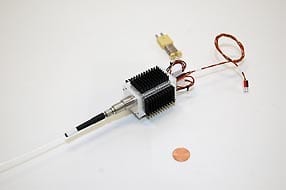It is cheap to make and can be produced in large quantities
A team of researchers from the University of Notre Dame in Indiana is reporting the creation of a “solar paint” that could mark an important milestone on the road to widespread implementation of renewable energy technology. Although the new material is still a long way off the conversion efficiencies of commercial silicon solar cells, the researchers say it is cheap to make and can be produced in large quantities.
In an effort to find an alternative to silicon-based solar cells, the Notre Dame researchers turned to quantum dot materials. They started with nanoparticles of titanium dioxide (TiO2) and coated them with either cadmium sulfide or cadmium selenide – both compounds that can absorb photons. A photon of the right energy hitting the cadmium compounds causes an electron to escape, which is absorbed by the TiO2.
The resultant particles were then suspended in a water-alcohol mixture to create a paste. The cadmium sulfide mixture produced a yellow paste, while the cadmium selenide mix produced a dark brown. The most efficient was a mixture of the two that produced a light brown paste.
When the paste was brushed onto a transparent conducting material and exposed to light, it created electricity. To replenish the electrons lost by the cadmium and test the conversion efficiency of the paint-on electrode, cathodes made from other materials and additional compounds were used.
Bookmark this page for “solar paint” and check back regularly as these articles update on a frequent basis. The view is set to “news”. Try clicking on “video” and “2” for more articles.









